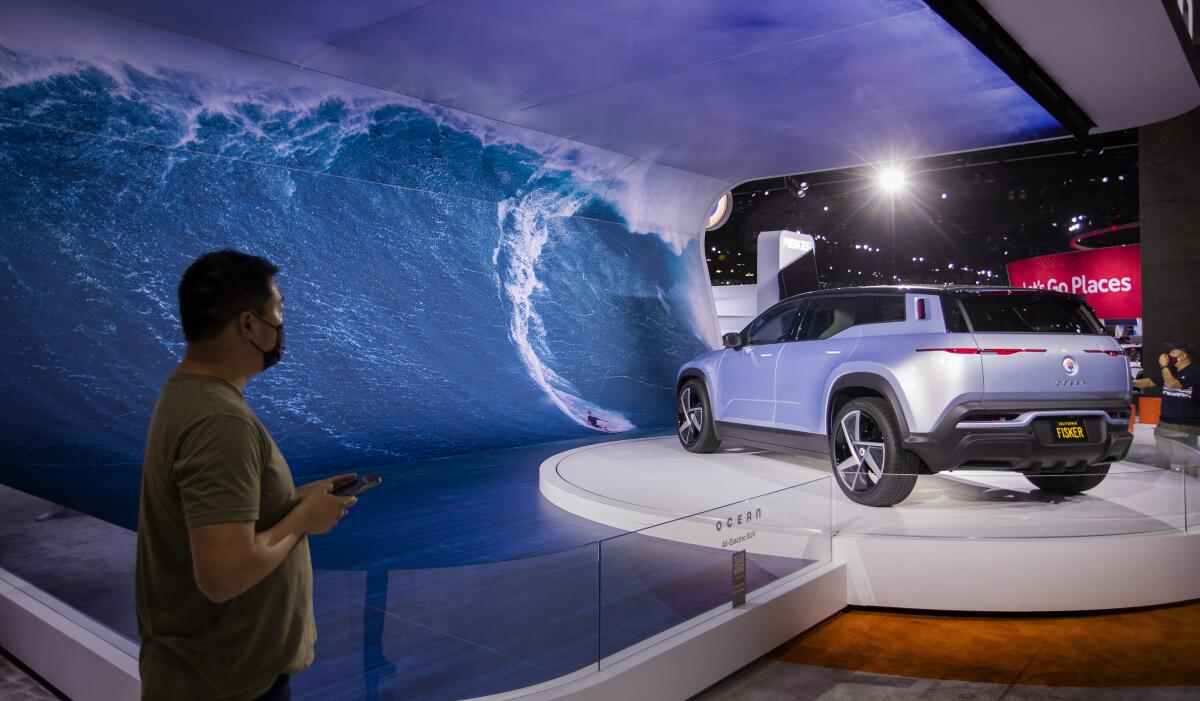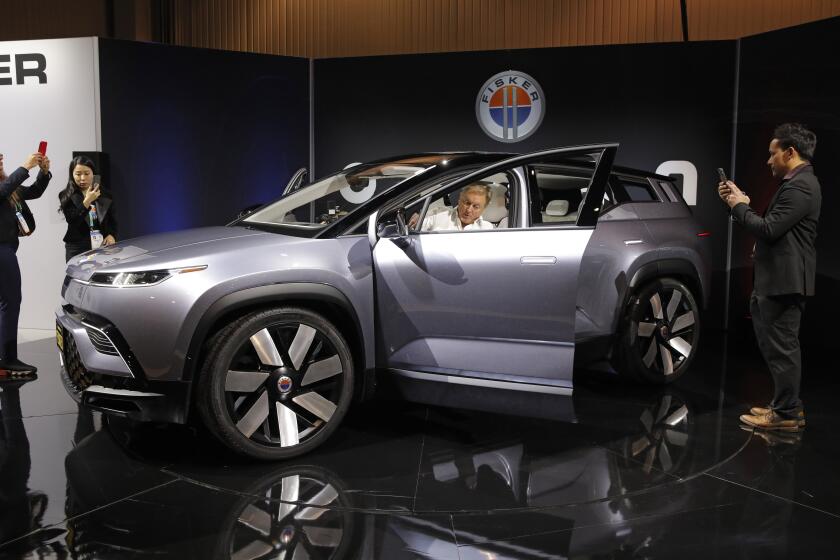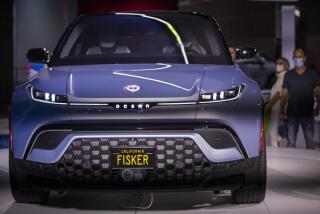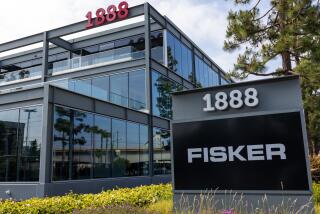EV maker Fisker to be liquidated under plan to keep owners on the road

- Share via
Troubled electric vehicle maker Fisker Inc. has reached a settlement with creditors that will allow it to liquidate its assets while working with owners to keep their pricey SUVs on the road.
The company filed for Chapter 11 bankruptcy protection in June after failing to reach a strategic agreement with another automaker that could provide it with more capital and domestic manufacturing capacity.
Manhattan Beach EV maker Fisker Inc. said it was halting production of its snazzy Ocean SUV, seeking financing and a strategic partner in a further setback for car designer Henrik Fisker.
The global agreement reached Friday in U.S. Bankruptcy Court in Delaware allows Fisker management to remain in charge for some time as the operation winds down.
That was important to Fisker, the National Highway Traffic Safety Administration and car owners, who filed objections to converting the bankruptcy to Chapter 7, noting the startup’s only vehicle — a premium SUV called the Ocean — has several open recalls for faulty door handles, loss of power and other problems.
“The owners strongly believe that Fisker owes them a responsibility to ensure that their vehicles are safe and operable, and that the best way for Fisker to fulfill that promise is through a Chapter 11 process,” said attorney Daniel Shamah, who represents the Fisker Owners Assn. “We can be sure that employees and the advisors who are helping the company do this remain on board.”
The liquidation plan, which details how proceeds from asset sales will be distributed among various creditors, is subject to a vote by all unsecured creditors.
The plan also calls for the owners association to have a voice in the sale of Fisker’s intellectual property, which includes the designs and computer code that were necessary to build and operate the vehicles. The owners need long-term access to Fisker’s “cloud software,” which is crucial for sending over-the-air updates to the vehicle software that controls the Ocean.
Other issues, including access to parts and long-term service, are still being negotiated outside the bankruptcy process, Shamah said.
However, with secured and unsecured claims against the company likely to top $1 billion, shareholders who invested in Fisker are unlikely to get their money back.
“It’s a virtual certainty that there will be no money for equity. There’s no way you’re going to have enough to pay claims in full in this liquidation,” said David Golubchik, a veteran bankruptcy attorney at Levene, Neale, Bender, Yoo & Golubchik in Los Angeles.
Founded in 2016 by auto designer Henrik Fisker, the company went public in 2020 via a SPAC, or special purpose acquisition company, backed by private equity firm Apollo Global Management. The company raised $1 billion in equity capital and borrowed even more, but ran out of money and only sold about 7,000 of its vehicles.
The Ocean was envisioned as a competitor to Tesla’s Model Y, but Fisker had trouble making and delivering the snazzy SUV through a direct sales model borrowed from Tesla. The SUV also was plagued by software glitches, though its ride and build were praised.
Fisker made more than 11,000 Oceans before it stopped production, according to a court filing. The bankruptcy court already has approved the sale of the company’s remaining inventory of 3,321 Oceans, which were acquired for $46.25 million by American Lease, a Bronx, N.Y., business that leases Uber and Lyft cars.
Fisker, which was based in Manhattan Beach before shutting down its headquarters and moving to Orange County, has few other hard assets.
Henrik Fisker, the chairman and chief executive, built the company to be asset light, with vehicles assembled at an Austrian factory owned by a subsidiary of Magna International, a Canadian manufacturer of automobile components.
Fisker’s most valuable asset might be its intellectual property, but it’s unclear what bids it may attract.
The settlement came after discussions among Fisker and its secured and unsecured creditors following a dispute over whether to convert the case to a Chapter 7 liquidation run by a trustee.
The conversion was sought by the company’s largest secured creditor: CVI Investments and its investment manager, Heights Capital Management Inc., both affiliates of Susquehanna International Group, a large Pennsylvania trading firm founded by billionaire Jeff Yass.
CVI argued the administrative costs of operating under Chapter 11 were draining and that were was little likelihood the company would remain in business.
However, its status as a legitimate secured creditor was questioned by the Committee of Unsecured Creditors, including U.S. Bank, which has filed a $681-million claim related to Fisker notes it holds.
Last year, Fisker sold convertible notes to CVI, receiving gross proceeds of $450 million, according to a court filing by the unsecured creditors. Fisker filed its third-quarter earnings report late, technically defaulting on the notes and converting them into secured debt.
The committee alleged that CVI profited an estimated $57 million from the sales of its converted shares, diluting the stock and driving its price under 10 cents a share this year.
Shareholders, in letters to the court, have called for the Securities and Exchange Commission to look into CVI’s and Height’s roles in the bankruptcy, including potential short selling that may have driven Fisker’s shares to pennies. Attorneys for CVI and Heights did not return messages seeking comment.
Fisker has received a subpoena from the SEC, The Times reported last week. It is unclear what information the agency is seeking.
The company is facing multiple shareholder lawsuits that focus on Fisker’s late third-quarter filing and the role it played in the collapse of the stock price. In 2021, the company’s market cap approached $8 billion before shares traded at pennies prior to the bankruptcy filing.
The lawsuits included allegations that Fisker, his wife Geeta Gupta-Fisker (the company’s co-founder, chief financial officer and chief operating officer) violated their fiduciary duties and securities laws. The company declined to comment.
Fisker’s stake in the company is now virtually worthless, but he sold about $20 million worth of shares in 2021 well before the stock declined. Fisker and his wife also received bonuses in December of a little more than $1 million each, which were disclosed last week in a bankruptcy court filing by Fisker. The company declined to comment on the reason for the bonuses.
Evan Scott, 39, who owns a Fisker Ocean and figures he lost about $50,000 on the company’s stock, said he was shocked to learn about the bonuses.
“As a shareholder and a car owner who had supported Henrik and his wife, I am seeing red,” Scott said. “They knew the company was in dire straits. They were just expediting bankruptcy by doing that.”
More to Read
Inside the business of entertainment
The Wide Shot brings you news, analysis and insights on everything from streaming wars to production — and what it all means for the future.
You may occasionally receive promotional content from the Los Angeles Times.












